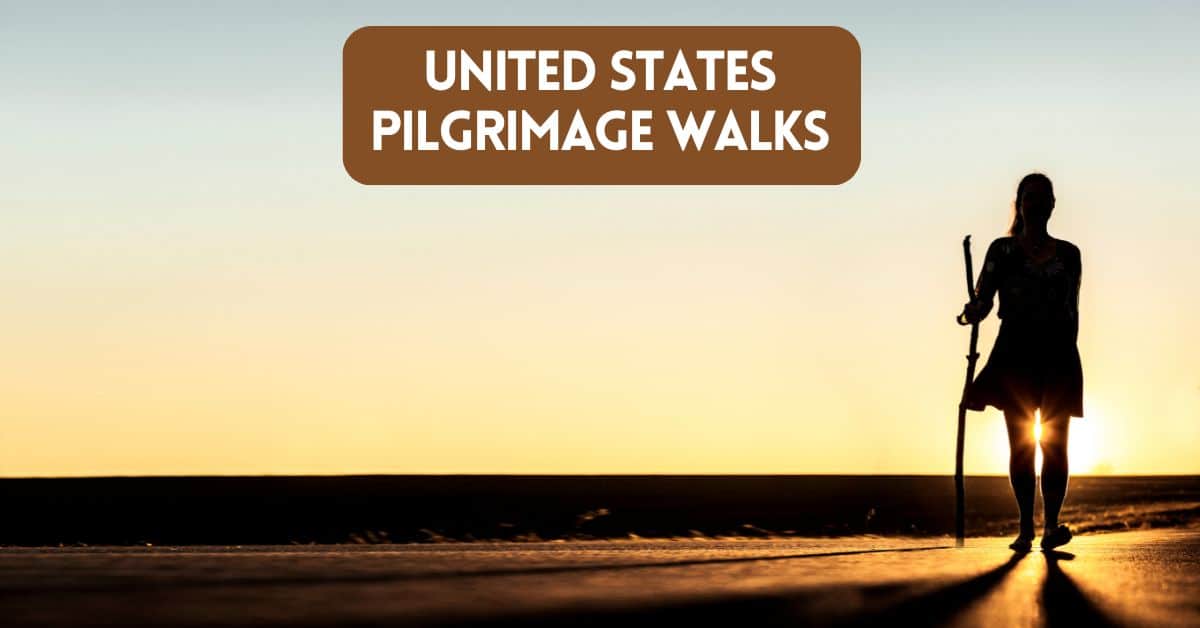Discovering The Most Inspiring USA Pilgrimage Walks
In the heart of a wanderer lies the ceaseless yearning for something more – a quest that can often lead to spiritual transformation. What better way to fulfill this urge than through Pilgrimage Walks in the USA?
Whether you’re seeking a day’s escape or a month-long sojourn, the varied tapestry of trails here accommodates every seeker’s schedule and spirit. Our footprints have traced over 100 miles across the contemplative California Mission Trail, each step a story, each mile a memory. We’ve even captured our jaunts on video, sharing our experience on YouTube to guide and inspire future pilgrims on their sacred tramps.
You too can step into a realm where every path is a meditation and every destination a discovery of self. Join us as we unveil the soul-stirring possibilities of Spiritual Journeys across blessed terrains in the United States. Learn about the myriad of trails available so you can find authentic pilgrimage walks in the USA to suit your stride and timetable.
Welcome to the beginning of your own legendary passage.
The Places Where We Go contains affiliate links and is a member of the Amazon Services LLC Associates Program. As an Amazon Associate, we earn from qualifying purchases at no extra cost to you when you purchase using one of these Amazon links. Read our disclaimer and privacy policy for more information.
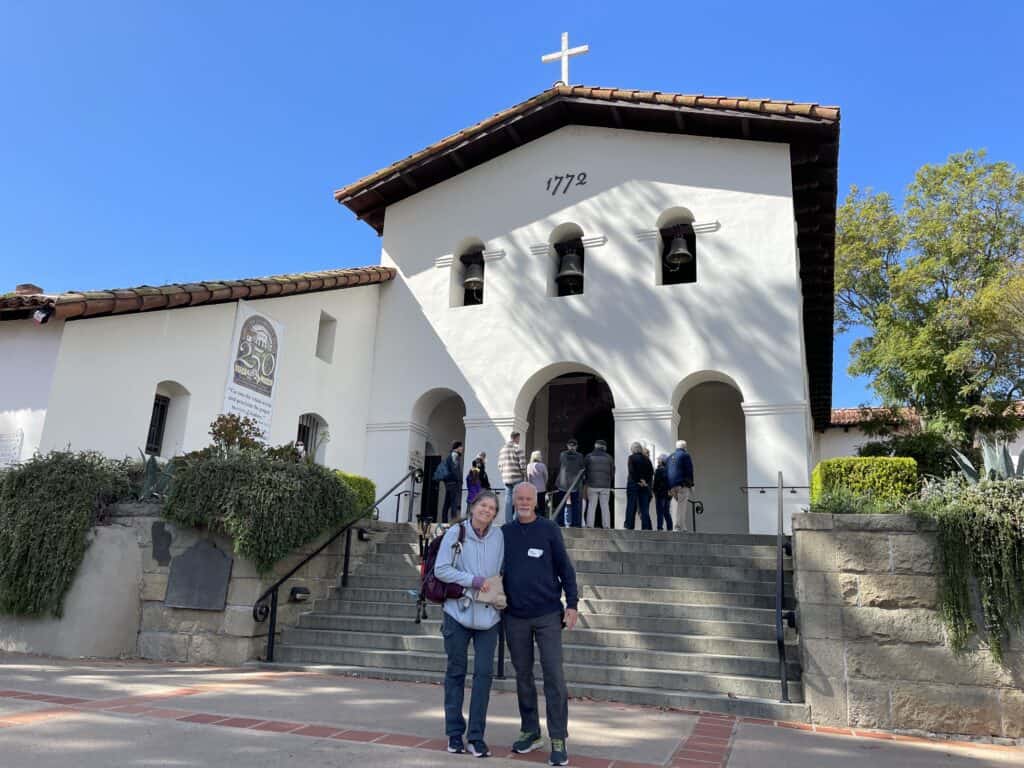
Pilgrimage Walks in the USA
The Modern American Pilgrimage
The spirit of pilgrimage has long been an essential part of human history and the quest for meaning. In the vast expanse of the United States, a nation stitched together by stories, the tradition of pilgrimage is evolving, winding through bustling cities and serene wilderness alike. Explorers of faith and seekers of solace find their call among the myriad paths that crisscross the country’s diverse landscapes. As religious tourism sees a renaissance, this guide about Pilgrimage Walks in the USA invites you to experience sacred walks through the American landscape.
In today’s fast-paced world, “pilgrimage” may conjure images of a bygone era. Yet, for a growing number of modern Americans, the desire for deeper spiritual connection and personal growth is leading to a revival of this ancient practice. More than mere hiking trails, modern pilgrimage walks offer a blend of spiritual, historical, and physical challenges. They allow one to step outside the ordinary, reflect, and mark personal milestones.
Growth in Pilgrimage Participation
Exact figures for annual participants in pilgrimage walks in the United States are hard to pinpoint due to the diverse nature of these activities. Annually, an estimated tens of thousands of Americans engage in some form of pilgrimage walk. These walks vary from shorter, more accessible routes to extensive trails that span several states or regions.
Cultural Influence on Pilgrimage Interest
Cultural portrayals of pilgrimage, such as the movie “The Way,” directed by Emilio Estevez and starring Martin Sheen, significantly boost pilgrimage interest. This film, which highlights a father’s journey on the Camino de Santiago after the death of his son, has inspired many viewers to embark on their own pilgrimage walks. Its impact highlights how media can influence personal and spiritual exploration, increasing interest in domestic and international pilgrimage routes.
When we first watched “The Way,” it inspired us. We began taking long walks, thinking we would make it to the Camino de Santiago. Our first significant hike included the nearly 70-mile Backbone Trail of the Santa Monica Mountains in Southern California. We also learned about the California Mission Trail in our own backyard. While this California Camino is even longer than the main route famous in Spain, we have walked to three California missions so far.
Pilgrimage Walks in the USA
The Concept of Pilgrimage in Modern America
Pilgrimage, in its essence, is a journey of spiritual significance. It is a physical and mental voyage that seeks to deepen one’s connection with oneself, others, and the divine. In modern America, pilgrimage walks have gained popularity as a way for individuals to embark on a personal quest for growth and meaning through traversing holy paths.
The concept of pilgrimage in modern America is deeply influenced by the country’s diverse cultural and religious landscape. Each pilgrim brings their unique beliefs, motivations, and intentions to their journey, making it a deeply personal experience. This diversity is reflected in the wide range of routes available for pilgrimage walks in the USA, catering to various spiritual traditions and ideologies.
Moreover, modern American pilgrimage walks are not limited to traditional religious routes. They also encompass secular paths that hold historical, cultural, or personal significance to the pilgrim. This inclusivity allows for a more personalized and inclusive approach to pilgrimage, making it accessible to individuals from all backgrounds.
In essence, pilgrimage walks in the USA offer a way for individuals to embark on a transformative journey without having to travel to distant lands.
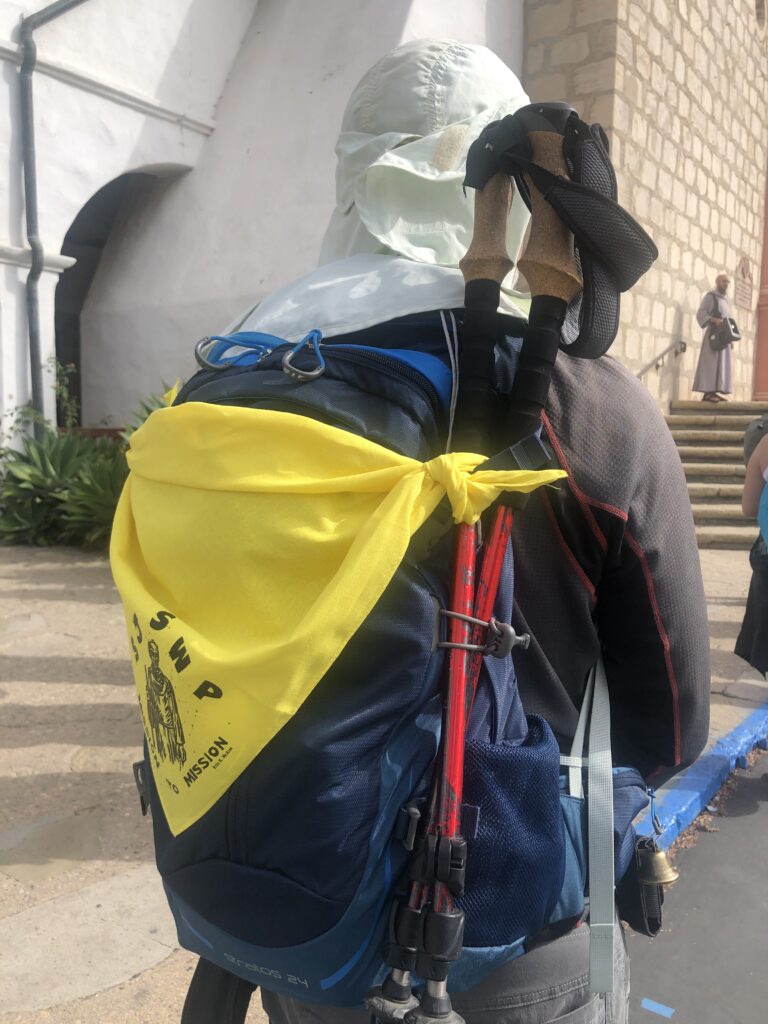
Pilgrimage Walks in the USA
Pilgrimage is a tradition woven into the fabric of many American cultures, from the indigenous peoples’ spiritual journeys to the Christian crusades that brought Spanish missions and settlements to the West or the Mormon exodus seeking religious freedom. Today, these paths beckon to the faithful and adventurous alike, promising to reveal the natural beauty of the American landscape and speak to the soul in profound ways.
The California Missions Trail
Some may be familiar with the world famous Camino de Santiago in Spain. But did you know there is a California Camino? It offers nearly 800 miles of travel between the California Missions in San Diego to Mission San Francisco Solano in Sonoma.
The California Missions Trail connects 21 historic Spanish missions and offers a fascinating perspective on California history and a deeply rooted religious narrative. Some people refer to this trail as the American Camino.
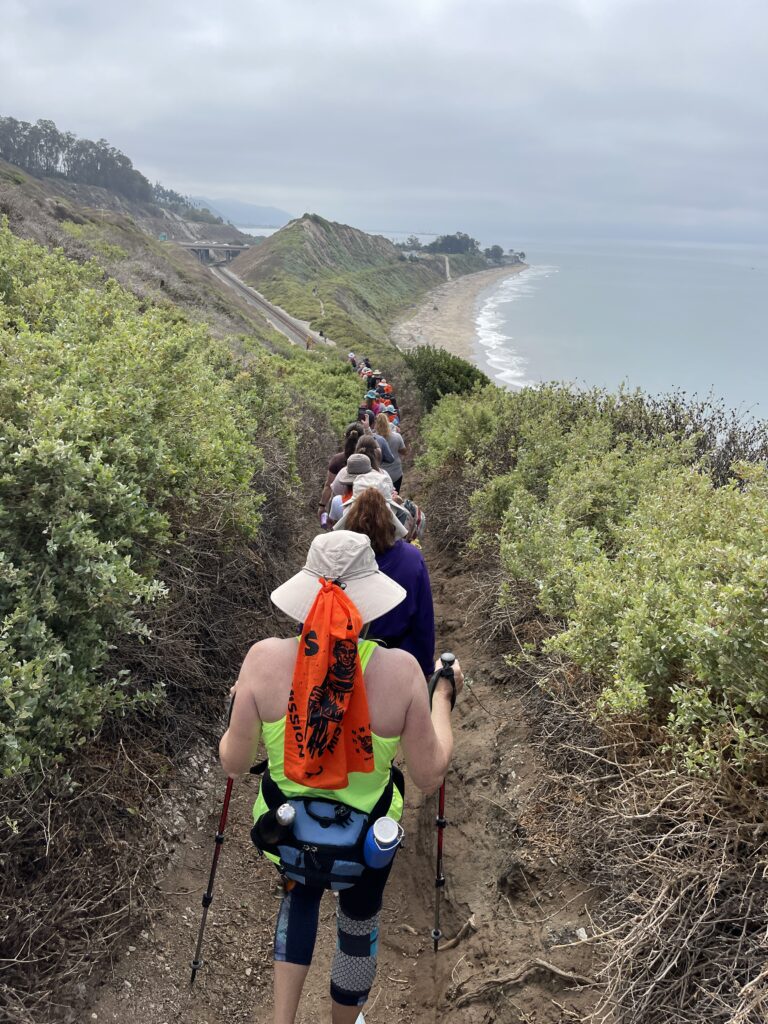
This trail not only offers a unique perspective on the state’s history but also holds deep religious significance for many who embark on the journey. It is a physical representation of the spread of Christianity in the West and allows pilgrims to experience the diverse landscapes and cultures of California.
Pilgrims on this route will have a chance to stop at San Juan Capistrano Mission which is the oldest building still in use in California. It is also the only surviving church where Saint Junipero Serra said Mass.
This is among the ultimate pilgrimage walks in the USA. It is a must-visit pilgrimage experience for those seeking spiritual growth and connection with both nature and history in the United States. The California Mission Trail also serves as a reminder of the impact that religion and faith have had on shaping American culture and identity.
Best Times: Late Fall to Early Spring (November to March)
- Reasons: Southern California experiences hot summers that can make long-distance walking uncomfortable. The cooler months provide a more temperate climate, ideal for walking. Additionally, this period avoids the rainy season, ensuring the trails are more passable and the experience more pleasant.
Resources for the California Missions Trail
If you’re interested in learning more about El Camino Real California and its 21 missions, check out the links below for more information.
- California Mission Walkers Store (Trail guide, Passport, Patch and more)
- California Mission Walkers Facebook Page
- Saint Junipero Serra Walking Pilgrimage
National Eucharistic Pilgrimage – St. Katharine Drexel Route
The 2025 Drexel Route opens with a Mass of Thanksgiving in Indianapolis on Sunday, May 18th. The team will travel with the Blessed Sacrament through parts of the Midwest before heading to Texas and along the states of the Southwestern United States. This year’s pilgrimage route will include numerous opportunities to encounter Jesus, including daily Mass, Eucharistic Adoration, Eucharistic Processions, witness talks, and fellowship meals with the Perpetual Pilgrims.
The pilgrimage will visit the tomb of Venerable Servant of God Archbishop Fulton Sheen, the Shrine of Blessed Stanley Rother, and stop at several missions in Southern California. Another highlight of the journey is a stop at St. Michael Church near Window Rock, which is the capital of Navajo Nation. The St. Katharine Drexel route comes to an inspiring conclusion during Corpus Christi weekend in Los Angeles, where we will process with our Lord around the downtown Cathedral of Our Lady of the Angels.
Dates: May 18 – June 22, 2025
Website: https://www.eucharisticpilgrimage.org/
Saint Junipero Serra Walking Pilgrimage
The annual St. Junipero Serra Walking Pilgrimage honors the patron saint of California by retracing his steps along the stunning 35-mile El Camino Real. This two-day trek between missions is designed to balance safety, beauty, and a heartfelt connection to faith, offering participants the chance to enjoy prayer, camaraderie, and spiritual reflection alongside friars, priests, and sisters.
With camping gear transported, meals provided, and plenty of hydration stops, you can fully immerse yourself in the breathtaking scenery and the joy of the journey. Whether you walk the entire route or join highlights like the gentle 3-mile descent to the ocean from Mission Santa Barbara or the final procession to Mission Basilica, everyone is welcome to experience this meaningful adventure.
Dates: August 9-10, 2025
Website: https://www.stserrapilgrimage.org/
El Camino de San Antonio Missions
The El Camino de San Antonio Missions is a 14-mile walk that connects all five of the mission sites in San Antonio, Texas. The route includes paved sidewalks, roads, and gravel trails, providing an accessible and informative experience for walkers interested in learning about the history of these missions. Along the way, visitors can explore each mission site, learn about their significance in the local culture, and experience the vibrant culture of San Antonio. This pilgrimage walk offers a unique mix of spirituality, history, and modern city life for pilgrims seeking a diverse and enriching journey.
We journeyed this trail on e-bikes which are available throughout the city of San Antonio. This made the journey quicker than walking and allowed us to easily get to each of the missions in a single day. You can see our visit on our YouTube video – Biking the San Antonio Missions recapping our trip to the San Antonio Missions.
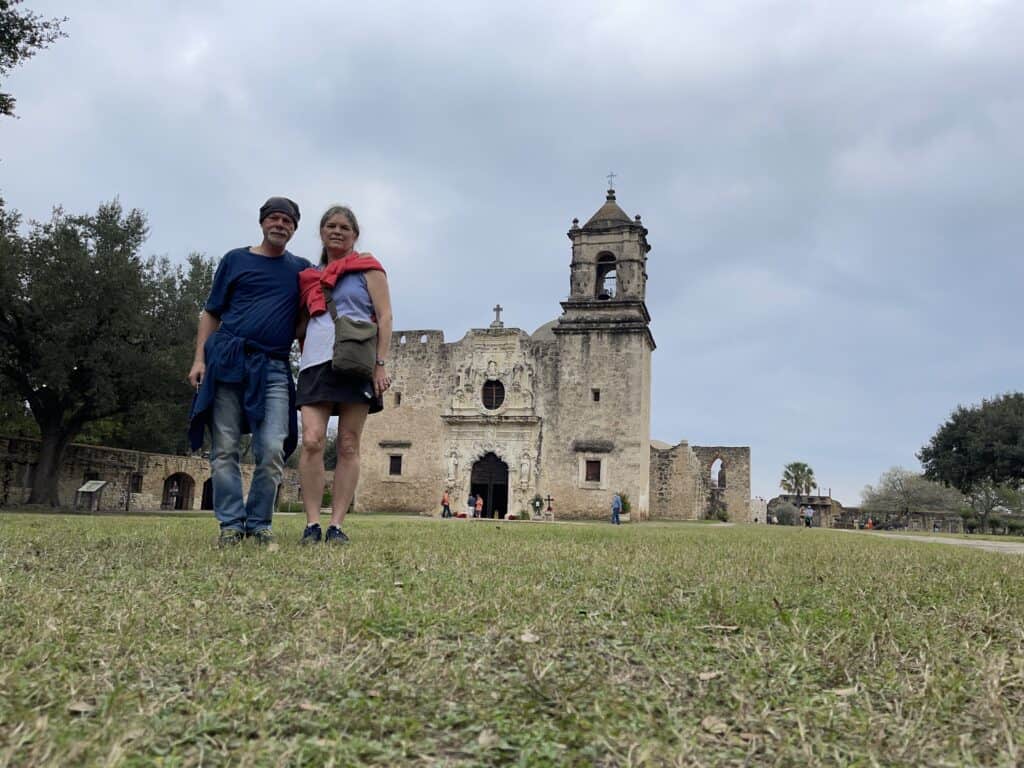
The Camino of San Antonio includes:
- San Fernando Cathedral – The oldest continuously functioning cathedral in the United States
- Mission Nuestra Señora de la Purisima Concepción – The oldest unrestored stone church in the United States
- Mission San José y San Miguel de Aguayo – Known as “Queen of the Missions”
- Mission San Juan Capistrano – Closest to the San Antonio River which provided the missions with water
- Mission San Francisco de la Espada – Home to a crucifix containing a relic of Saint John Paul II
Get Credit Toward The Camino de Santiago
Are you interested in walking the Camino de Santiago but getting experience first in the United States. Among USA pilgrimage walks, this one to add to the top of your list.
San Antonio is the only place outside Europe where you can get an official start of walking Europe’s El Camino de Santiago. Pilgrims who complete the entire San Antonio route qualify to receive a 30 kilometer credit toward the Camino Ingles (English route) along the El Camino de Santiago. This makes the El Camino de San Antonio part of an official route of the Camino in Spain.
Resources for the El Camino de San Antonio Missions
Find Lodging In San Antonio
Walking Pilgrimage USA
Walking Pilgrimage USA is a 64-mile route that connects the Shrine of Our Lady of Czestochowa in Doylestown, Pennsylvania with the National Blue Army Shrine of the Immaculate Heart of Mary in Great Meadows, New Jersey. The pilgrimage walk takes participants through scenic countryside and quaint towns, providing an opportunity for spiritual reflection and connection with nature.
This route follows in the footsteps of early European settlers and offers a unique glimpse into the rich cultural history of the Northeastern United States. It is a pilgrimage that combines physical challenge, spiritual growth, and historical significance.
Along the way, participants can visit various holy sites and engage in religious ceremonies, making it a truly immersive and meaningful experience for all who embark on this journey. Walking Pilgrimage USA offers an unforgettable journey through the heart of America. The pilgrimage is held annually in August, with participants joining together in prayer and camaraderie to complete.
Resources for Walking Pilgrimage USA
Czestochowa Walking Pilgrimage (New Jersey to Pennsylvania)
Find Lodging Near The American Shrine of Our Lady of Czestochowa
National Latin Mass Pilgrimage
The National Latin Mass Pilgrimage advocates for the full restoration of the Traditional Latin Mass (TLM). Beginning at 9 a.m. on Saturday, October 5, 2024, at the Cathedral of St. Thomas More in Arlington, VA, pilgrims will walk approximately seven miles to the Cathedral of St. Matthew the Apostle in Washington, D.C. This pilgrimage serves as an act of penance and reparation for the restrictions placed on the celebration of TLM and highlights its beauty and evangelistic power. The procession will feature a Marian procession, including prayers, hymns, banners, crucifixes, statues of Our Lady, and the recitation of the traditional Divine Office and the Angelus.
Participants who cannot make the walk are encouraged to join the prayer at St. Matthew’s by 12:30 p.m. This event reflects the ongoing commitment to public acts of faith and dedication to preserving the Western liturgical patrimony. Interested individuals can refer to the provided plan and music resources for more details, including route information and hymn resources.
Resources for the National Latin Mass Pilgrimage
National Latin Mass Pilgrimage Website
Facebook link: National Latin Mass Pilgrimage
Find Lodging in Washington D.C.
Our Lady of Martyrs Pilgrimage
The Our Lady of Martyrs Pilgrimage in Auriesville, New York is a significant religious event that honors the lives and sacrifices of saints and martyrs who lived and died on Mohawk land centuries ago. This pilgrimage is held annually during the first weekend in August, attracting thousands of pilgrims from all over the country to walk in their footsteps and pay homage to their legacy.
The pilgrimage begins at the National Shrine of the North American Martyrs, where participants can attend Mass and engage in various religious activities. Then, pilgrims walk approximately seven miles to the Coliseum Shrine of Our Lady of Martyrs, located on top of a hill overlooking the Mohawk River Valley. Along the way, they stop at several shrines dedicated to the martyrs and saints, offering prayers and reflections.
This pilgrimage not only commemorates the lives of these holy men and women but also serves as a reminder of the ongoing struggle for religious freedom and tolerance in today’s world. The beautiful natural surroundings of upstate New York provide a serene backdrop for this spiritual journey and allow pilgrims to connect with nature while deepening their faith.
Resources for Our Lady of Martyrs Pilgrimage
Website: Pilgrimage to the Shrine of North American Martyrs
The Wisconsin Way
The Wisconsin Way is a 200-mile pilgrimage route through the heart of Wisconsin, starting from St. Croix Falls and ending at the Shrine of Our Lady of Guadalupe in La Crosse. This pilgrimage route offers a unique blend of natural beauty, historical landmarks, and religious significance for all who embark on it.
Pilgrims on this route will pass through charming towns, rolling hills, and peaceful farmlands as they make their way towards the Shrine of Our Lady of Guadalupe. Along the way, they can visit historic churches and shrines, including the National Shrine of Mary Help of Christians at Holy Hill in Hubertus.
The Wisconsin Way offers pilgrims an opportunity to disconnect from the fast-paced world and connect with nature, history, and spirituality. It is a journey that will leave a lasting impression and deepen one’s faith. So, it is a must-visit pilgrimage for those seeking a unique and enriching experience in the heart of America.
Best Time: The best time to embark on The Wisconsin Way is during the fall months (September to November). The cooler temperatures and vibrant fall foliage make for a picturesque journey. Additionally, the route is less crowded during this time, allowing for a more peaceful and reflective experience.
Resources for The Wisconsin Way
Website: The Wisconsin Way Pilgrimage
Missouri River Shrines
The Missouri River Shrines Pilgrimage is a 200-mile route that connects seven Catholic shrines in the state of Missouri. This pilgrimage offers participants a chance to explore the rich religious history of the state and deepen their connection with their faith. The journey takes pilgrims along the scenic Missouri River, offering stunning views and opportunities for spiritual reflection.
This beautiful journey through the heart of Missouri is a must-visit for those seeking a meaningful and enriching pilgrimage experience. The shrines along the way offer various activities and services, making it a great pilgrimage option for families and individuals of all ages. With its blend of natural beauty, historical significance, and religious devotion, the Missouri River Shrines Pilgrimage is a truly unique and memorable experience.
Best Time: The best time to embark on this pilgrimage is during the spring, when the weather is mild and the route is lined with blooming wildflowers.
Resources for Missouri River Shrines Pilgrimage
Website: Katy Trails Pilgrimage
Basilica of the National Shrine of the Immaculate Conception – A Pilgrimage Church
The Basilica of the National Shrine of the Immaculate Conception, recognized as a sacred pilgrimage church by the United States Conference of Catholic Bishops, stands as the preeminent Marian Shrine in the United States. It offers pilgrims the opportunity to experience the grace and indulgences typically associated with the great Marian shrines across the globe. With over 80 chapels dedicated to the Virgin Mary and reflecting traditions from various cultures, visitors can partake in guided tours, private or Shrine Masses, enjoy meals at the cafeteria, and visit the gift shops for religious mementos. The Basilica also features serene outdoor spaces such as Mary’s Garden or the Rosary Walk and Garden, providing a comprehensive pilgrimage experience.
Resources for National Shrine of the Immaculate Conception Pilgrimages
Website: National Shrine of the Immaculate Conception Pilgrimages
Find Lodging Near The National Shrine of the Immaculate Conception
The Mormon Pioneer Trek
Retrace the history of the Church of Latter-day Saints along the 1,300-mile Mormon Pioneer Trail, where faith, resilience, and the American West converge.
Best Times: Late Spring (May to early June) and Early Fall (September)
Reasons: Summer can be exceedingly hot, especially across the plains and mountain passes, making the journey strenuous. Late spring and early fall offer milder temperatures and less severe weather conditions, reducing the risk of encountering snow in the higher elevations or extreme heat in the lower plains.
Sacred Door Trail
The Sacred Door Trail is a purposeful 200-mile pilgrimage in southwestern Montana, looping through natural splendors like mountains, valleys, and waterways. Designed to deepen connections with oneself, others, and the earth—which encompasses spiritual diversity and unity—this pilgrimage trail was consecrated by various communities in 2012. The trail’s essence is enhanced through intentional hiking, resulting in personal insights and communal enrichment. It stands as a symbol of unity and a call to action, inviting others to establish similar projects that honor the land’s deep historical ties with indigenous tribes such as the Selis, Newe, and Nimiipuu.
Preparing for Your Pilgrimage
Undertaking a pilgrimage, whether for religious or personal reasons, entails a marked dedication. Preparing for the trek’s physical rigors, understanding the route’s significance, and allowing oneself to be enveloped by walking are critical parts of the journey.
Careful preparation is vital to a successful pilgrimage. From physical training to spiritual reflection, learn what you need to do before you set out on your walk. When preparing for a pilgrimage walk, especially if it’s your first time, considering several factors helps to ensure a rewarding and safe experience. Here are detailed preparation tips covering physical, mental, and logistical aspects:
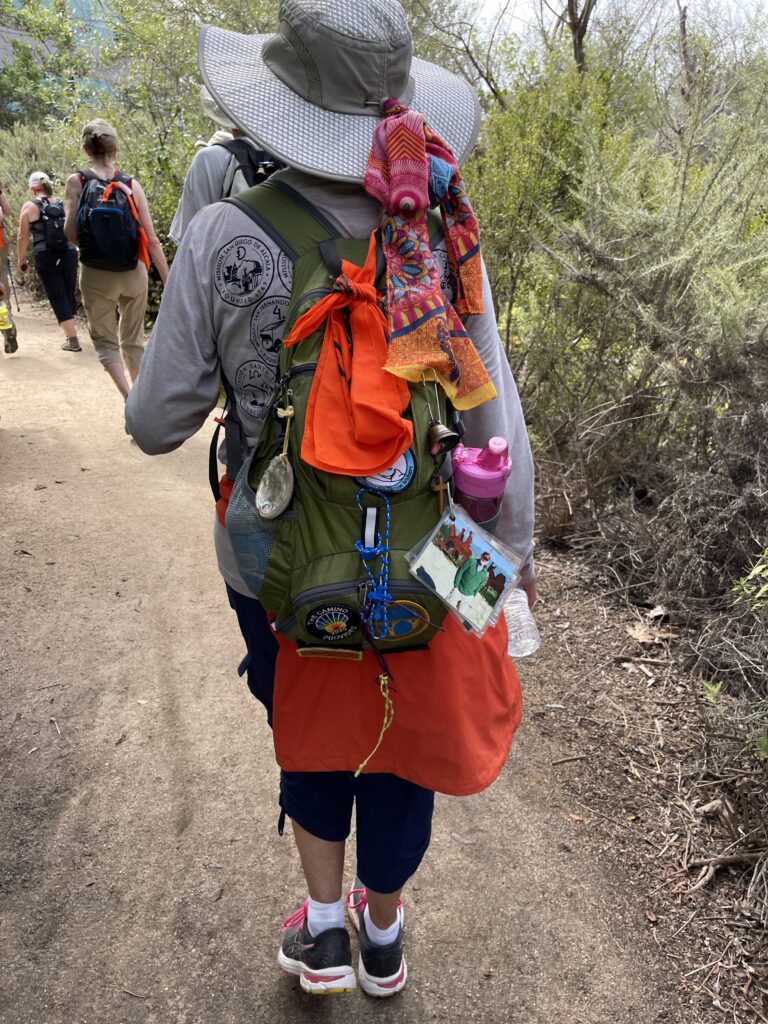
Physical Preparations
- Start Training Early: Begin walking regularly several months before your pilgrimage. Gradually increase your distance and include varied terrain to build stamina and get accustomed to long walks.
- Gear Up: Invest in good-quality and comfortable footwear. We favor trail runners on our walks. Breaking in your shoes before a big hike helps minimize blisters. Wear appropriate clothing for varying weather conditions—think layers, breathable fabrics, and moisture-wicking materials.
- Practice with Your Pack: Carry the backpack you’ll use on several of your training walks. Make sure it fits well, isn’t too heavy, and distributes weight evenly. Aim to carry no more than 10% of your body weight.
- Physical Check-up: Visit your healthcare provider for a physical check-up to ensure you’re fit for the journey. Discuss any existing health conditions and how to manage them on the trail.
Mental Preparations
- Set Realistic Goals: Understand your reasons for embarking on this journey. Set achievable goals based on your physical condition and personal aspirations.
- Familiarize with the Route: Research the pilgrimage route thoroughly. Knowing key landmarks, rest spots, and challenging sections can help mentally prepare you for what to expect.
- Stress Management: Develop strategies to handle stress or anxiety that may arise during long, potentially solitary walks. Techniques like mindfulness, meditation, or simple breathing exercises can be beneficial.
Logistical Preparations
- Itinerary Planning: Create a detailed plan including daily walking distances, overnight accommodations, and potential places to eat or resupply. Leave room for flexibility in case of unexpected changes or challenges.
- Safety Measures: Register your travel plan with a friend or family member. Carry a mobile phone with emergency numbers programmed. Consider a portable charger or solar charger for extended trips without access to power.
- Transportation and Permits: Arrange transportation to and from the starting point and ending point of your walk. Check if any part of your route requires permits or special permissions and secure these in advance.
- Pack Essentials: Prepare a packing list that includes:
- Navigation tools like a map, compass, or GPS device.
- Basic first-aid kit, including items like bandages, antiseptic wipes, and any personal medications.
- Water bottles, hydration system, and water purification tools if you’ll source water en route.
- Sun protection (sunglasses, sunscreen, hat).
- Nutritious, high-energy food items that are non-perishable.
- A light, compact sleeping bag and tent for overnight camping.
By thoroughly preparing physically and mentally and addressing logistical concerns in advance, you can embark on your pilgrimage walk feeling confident and ready to embrace the journey’s transformative potential.
Challenges on the Trail
A pilgrimage is not without its trials. Ensuring you’re well-prepared for the physical and emotional challenges of the trail will help you stay focused on your spiritual and personal goals.
Embarking on a pilgrimage walk can be an enriching experience. Still, like any significant endeavor, it comes with its challenges. Understanding and preparing strategies to overcome these challenges can make your journey smoother and more enjoyable. Here’s an expanded look at typical challenges faced on pilgrimage walks and how to address them:
Physical Challenges
- Fatigue and Exhaustion: Walking long distances day after day can lead to physical exhaustion.
- Solution: Ensure you have a reasonable and realistic walking plan, including rest days. Maintaining a balanced diet rich in carbohydrates and proteins is crucial to sustain energy levels.
- Blisters and Foot Pain: One of the most common complaints on long walks.
- Solution: Wear well-fitted, broken-in shoes and moisture-wicking socks. As a preventative measure, apply blister patches or tape to known hot spots.
Mental Challenges
- Loneliness and Isolation: The journey can become mentally taxing, especially if you are walking alone.
- Solution: Prepare mentally for periods of solitude. Before your trip, consider joining pilgrim communities online to make connections or plan parts of your walk with others.
- Doubt and Motivation Loss: You might sometimes question why you embarked on the pilgrimage.
- Solution: Keep a journal to remind yourself of your journey’s purpose and what you hope to achieve. Regular contact with loved ones can also provide moral support and motivation.
Logistical Challenges
- Weather Conditions: Weather can be unpredictable and impact your daily progress.
- Solution: Check forecasts regularly and prepare with the appropriate gear. Waterproof clothing, layered clothing for cold conditions, and a lightweight but sturdy tent for overnight trips are essential.
Health Challenges
- Dehydration and Nutrition: Insufficient water and food intake can lead to serious health issues.
- Solution: Carry a hydration pack and water purification methods (tablets, filters). Pack high-energy, nutritious snacks like nuts, dried fruits, and energy bars.
- Injuries: Sprains or more severe injuries can occur.
- Solution: Learn basic first aid, particularly handling sprains and minor cuts. Carry a well-stocked first aid kit and know the location of medical facilities along your route.
By preparing for these challenges, you can ensure a safer, more fulfilling pilgrimage experience. Remember, overcoming these hurdles is part of what makes a pilgrimage a transformative journey.
The Rewards of Pilgrimage
Pilgrimages offer a wealth of experiences and a multitude of rewards. From personal accomplishments to community bonds and spiritual insights, discover the benefits that await those who undertake these walks.
Pilgrimage walks are not just physical journeys but profoundly spiritual and communal experiences that offer numerous benefits. Many who undertake these walks find them transformative, leading to significant personal growth and a deeper connection with others. Here’s an expanded look at the spiritual and communal benefits commonly experienced on pilgrimage walks:
Spiritual Benefits
- Self-Reflection and Introspection: The solitude and the rhythm of walking provide a unique opportunity for deep self-reflection. Pilgrims often report gaining insights into their life decisions, personal relationships, and future aspirations.
- Renewed Sense of Purpose: Many embark on pilgrimages during transitional life phases or moments of personal crisis. The physical act of moving forward can metaphorically help participants move forward in other areas of their lives, often helping to clarify a new or renewed sense of purpose.
- Connection to Nature: Being outdoors and immersing oneself in the natural world can foster a profound sense of connection to the earth and its rhythms, often described as a spiritual experience.
- Spiritual Awakening or Deepening of Faith: For many, walking a pilgrimage route is a religious act that can lead to spiritual awakenings or deepen existing spiritual beliefs. The journey allows time for prayer, meditation, and engagement with sacred texts in a context unbound by the distractions of daily life.
Communal Benefits
- Shared Experiences and Solidarity: Pilgrimage routes often attract people worldwide, each with their own stories and reasons for their journey. The shared physical exertion and the common goal create a bond among pilgrims, leading to lasting friendships and a sense of community.
- Cultural Exchange: Walking through different regions exposes pilgrims to diverse cultures and practices, enhancing mutual understanding and respect. Engaging with locals and other pilgrims from various backgrounds can broaden perspectives and enrich the pilgrimage experience.
- Support and Encouragement: The communal nature of these journeys means that support is often available from fellow pilgrims and local communities along the route. This support can be instrumental in overcoming the physical and mental challenges of the walk.
- Collective Rituals: Participating in collective rituals, whether spiritual ceremonies at significant waypoints or communal meals at day’s end, reinforces a sense of belonging and shared purpose. These rituals can be deeply moving and add a rich layer to the pilgrimage experience.
Planning Your Pilgrimage
When planning a pilgrimage walk, having the right gear and resources is essential to ensure a safe and enriching experience.
Investing in comprehensive guidebooks and trail-specific resources can provide insights into the historical and spiritual significance of the sites along the route and practical information like water sources, accommodation, and food supplies.
Preparing with the right resources can enhance safety and ease of travel and deepen the pilgrimage experience, allowing walkers to focus more on the spiritual and personal aspects of their journey.
General Considerations
- Weather: Always check the long-term weather forecasts before planning your trip. Sudden changes can still occur, so be prepared with suitable gear.
- Local Events: Be aware of local festivals or religious events that might affect accommodation availability or path accessibility. These can be an opportunity for a richer cultural experience or a challenge due to increased crowds.
- Physical Preparation: Regardless of the season, ensure you are physically prepared for the challenges of the route, adjusting your gear and clothing to the expected weather conditions.
Choosing the right time to go can enhance your pilgrimage experience by providing more enjoyable weather conditions and a pace that suits your desire for solitude or community.
Your Pilgrimage Experience: Solo Traveler vs. Group Experience
Embarking on USA pilgrimage walks, either alone or with a group, can shape the journey in profoundly different ways. Here are some tips to consider for both scenarios to maximize the experience:
Traveling Alone
- Preparation is Key: When traveling alone, you must be well-prepared since you will rely solely on yourself. Learn to use navigation tools proficiently, and always have a backup plan.
- Safety First: Always let someone know your itinerary and check in regularly. Consider carrying a personal locator beacon (PLB) or a satellite messenger for emergencies, especially when walking in remote areas.
- Embrace Solitude: Traveling alone offers valuable time for reflection and personal growth. Bring a journal to document your thoughts and feelings, and use the time to meditate or engage in other mindful practices.
- Stay Open to New Connections: Even if you start your journey alone, you’ll likely meet other pilgrims. Be open to forming new friendships and sharing parts of your journey with others.
Traveling with Groups
- Choose Companions Wisely: Ensure your group’s goals, expectations, and physical abilities are aligned. Disparities can lead to frustration and compromise the experience.
- Establish Roles and Responsibilities: To manage group dynamics effectively, assign roles such as navigator, timekeeper, or lead planner. This division of labor can help the group function more smoothly.
- Communication is Crucial: Establish clear and open communication from the start. Discuss each day’s goals and be open to ongoing adjustments based on how the group feels.
- Plan for Alone Time: Even within a group, respecting individual needs for solitude is important. Allow time for members to walk alone for part of the day if they wish or engage in personal activities during breaks.
General Tips for Both Scenarios
- Pack Light and Right: Overpacking can hinder mobility and enjoyment, whether alone or in a group. Focus on essentials and share communal items like tents or cooking gear when in a group.
- Learn Basic First Aid: It is crucial to know how to handle common ailments and injuries, especially in remote areas. Every group member should have some basic first-aid knowledge and solo walkers should be well-versed in self-care.
- Be Flexible. Long walks often involve unexpected challenges. Being adaptable will help you overcome obstacles, whether alone or with others.
Ultimately, whether you walk alone or with others, each experience offers unique benefits and challenges. Solo walks can be powerful for personal reflection, while group trips can enhance the journey with shared experiences and support. In either case, thorough preparation and a mindful approach will lead to a meaningful pilgrimage.
Our Pilgrimage Experiences
Our USA pilgrimage walks experiences include traversing over 100 miles on the California Mission Trail, visiting the Basilica of the National Shrine of the Immaculate Conception, and traversing the San Antonio Mission Trail on bikes.
We’ve shared some of these experiences on The Places Where We Go podcast. Listen to hear about our personal experience with the California Mission Walkers group as well as the Saint Junipero Serra Pilgrimage Walk. You’ll find our story on episode 77 – USA Pilgrimage Walks.
You can also see our walks on YouTube. Here is a flavor of a Mission to Mission walk in California:
Resources for Aspiring Pilgrims
If you’re interested in USA Pilgrimage Walks, check out these additional resources:
Beyond the United States: Resources We Consult Regarding the Camino De Santiago
- A Pilgrim’s Guide to the Camino de Santiago (Camino Francés): St. Jean Pied de Port • Santiago de Compostela by John Brierley
- Camino Guide YouTube Channel
- Camino De Santiago YouTube Channel
Book Travel For Your Pilgrimage
Conclusion – Becoming a Pilgrim
In conclusion, pilgrimage walks in the USA are an invitation to the sacred—beyond distances marked on the map; we chart our own spiritual territory. You might be surprised by the number of pilgrimage sites in the United States.
Setting foot on these paths, whether solitary or among the fellowship of fellow pilgrims, brings us closer to history, nature, and our personal truths. It offers a rare and humbling insight into the shared human yearning for transcendence. Take the next step on your pilgrimage walk. The American earth is rich with the footprints of those who dared to seek a sacred path, awaiting the imprint of your soul’s sojourn.
For those who have taken pilgrimages in the land of the free, share your stories and insights and help the next wave of explorers to find their spiritual way. And for those who are just beginning to hear the call of the traveler’s quest, lace up your boots, for the road stretches out before you with the promise of discovery and renewal.
Thanks for reading this article. We hope to see you out on the pilgrim trail and at the places where we go.
Julie & Art
#pilgrimage #usapilgrimage #pilgrimagewalks
Pin it for later
Music To Inspire Prayer
Fuel your wanderlust with weekly travel updates – It’s 100% FREE!

